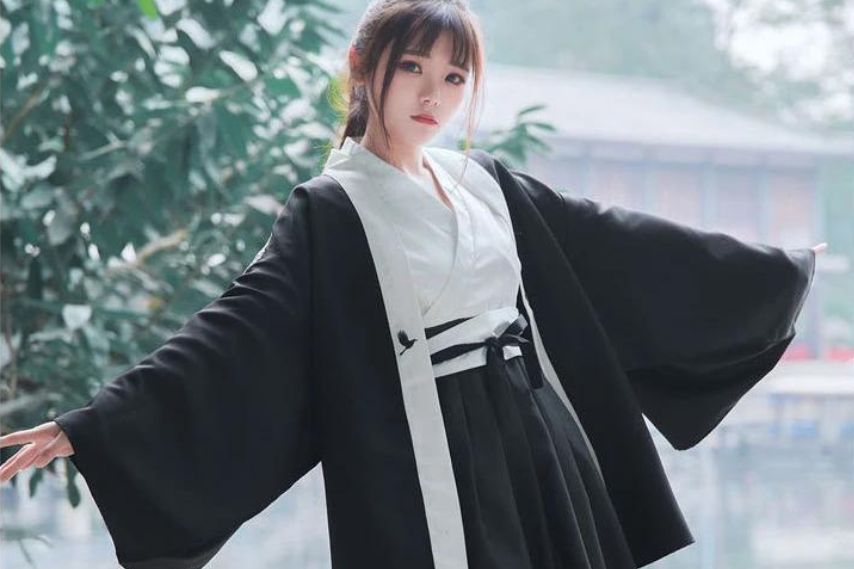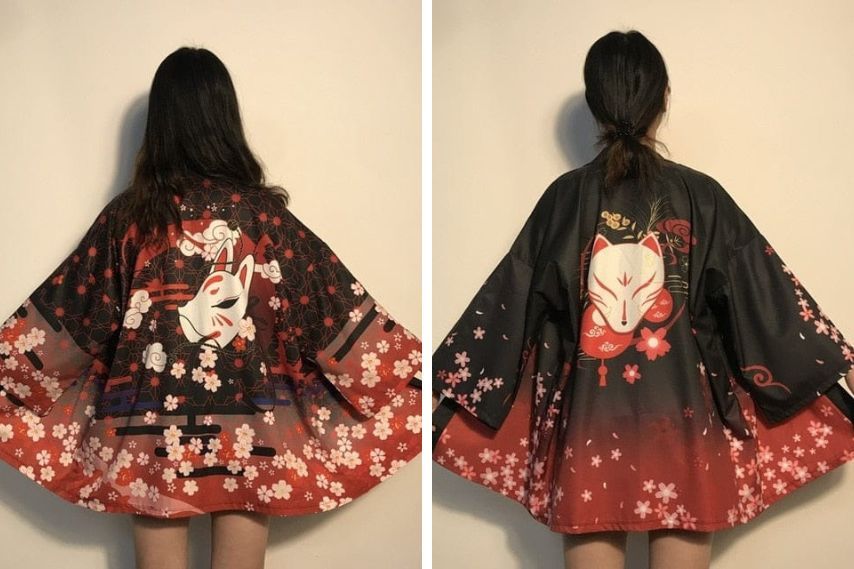Japanese Haori: A Symbol of Japanese Culture and Craftsmanship

Explore the captivating tale woven into the fabric of the Japanese Haori
The Japanese Haori is more than just a traditional Japanese garment; it's a vivid story woven in fabric, a tale of elegance, history, and culture. Picture this: a garment that once graced the backs of samurai, is now a cherished piece in modern wardrobes, transcending time and trends. This is the Haori, a symbol of Japan's rich sartorial legacy, and an enduring testament to its craftsmanship.
In the heart of Japan's bustling cities and serene countryside, the Haori is not just seen; it's experienced. It's the blend of the past with the present, a bridge connecting generations. From its origins as a practical garment for warriors to its current status as a versatile fashion piece, the Haori has journeyed through centuries, evolving yet retaining its profound cultural significance.
Here's a captivating fact to ponder: the Haori, traditionally worn by men, underwent a revolutionary transformation in the late 19th century as women began embracing it. This shift wasn't merely a fashion trend; it was a cultural statement, reflecting Japan's dynamic social landscape.
As we delve into the Haori's story, we'll explore the intricacies of its design, the skilled hands that craft each piece, and how it continues to be an integral part of both ceremonial attire and everyday fashion. Join me in unraveling the Haori's journey, a garment that is not just worn but celebrated as a piece of living history and art.
The Dawn of the Haori
Tracing its roots back to feudal Japan, the Japanese Haori was initially a practical garment for samurai warriors, offering ease of movement and warmth. As Japan transitioned into the peaceful Edo period, the Haori evolved, becoming a symbol of elegance and status among the elite. This era transformed the Haori from a functional item into a luxurious fashion element, rich in cultural significance and style.
The Haori in Modern Japan
In contemporary Japan, the Haori transcends its traditional roots, becoming a versatile and fashionable garment. It's now a staple in both formal and casual settings, reflecting the dynamic blend of Japan’s traditional values with modern aesthetics. The Haori's evolution into a contemporary fashion item illustrates the adaptability and enduring nature of Japanese cultural symbols.
The Art of Crafting Japanese Haori
Discover the exquisite artistry behind Japanese Haori, where fabrics and craftsmanship converge to create timeless elegance. Explore the rich heritage and contemporary allure of this traditional garment.
Exquisite Materials for Japanese Haori
Within the realm of Haori's creation, the fabric is the palette from which art is born. Each fabric type carries its own story, echoing through the centuries.
Silk's Elegance: The regal aura of silk Haori is unmatched. Sourced from regions like Gunma, where silk weaving traditions are cherished, it embodies sophistication. These Haori are reserved for special moments, shimmering with a grace that transcends time.
Cotton's Comfort: Cotton Haori, on the other hand, breathes life into everyday wear. They're beloved for their lightness and comfort, providing a canvas for daily expressions of style.
Wool's Warmth: Woolen Haori, a rarer find, offers a cocoon of warmth in colder seasons. They blend Japanese heritage with Western practicality, wrapping wearers in history's embrace.


The Craftsmen's Tale: Weaving Artistry into Haori
The creation of a Haori is not just a craft; it's an art form handed down through generations, a symphony of skill and creativity.
Designing: It commences with vision, selecting patterns that pay homage to tradition yet breathe with contemporary life. This stage walks a tightrope between honoring heritage and embracing the present.
Dyeing: Next is the art of dyeing, a ceremony steeped in history. Techniques like Shibori and Yuzen transform plain fabric into vibrant canvases. It's an intricate dance, where every fold and brushstroke imbues the Haori with a unique narrative.
Sewing: The final act is the meticulous assembly of the Haori. This is where the fabric's metamorphosis truly unfolds. Precision in cutting, aligning patterns, and expert stitching sets a master craftsman apart. As one artisan from Kyoto eloquently puts it, "Every stitch is a whisper of our culture, a story spun in fabric."
In the world of Haori making, each piece is a testament to the confluence of tradition and modernity, a fusion of history and contemporary style. It's not just a garment; it's a masterpiece that captures the soul and essence of Japan.
Japanese Haori Designs and Patterns
Embark on a visual journey through the intricate world of JapaneseOniMsks site's Haori designs and patterns, where each motif weaves a tale of culture, history, and artistry. Explore the rich tapestry of symbolism that adorns these garments, making them more than just clothing; they are living expressions of Japanese heritage.
An Array of Expressions
Haori, much like an artist's canvas, boasts a diverse spectrum of designs, colors, and styles. Each variation is a testament to the depth of Japanese aesthetics.
Floral Fantasia: Floral patterns are perennial favorites, capturing the delicate beauty of nature. Cherry blossoms symbolize the ephemeral nature of life, while chrysanthemums exude elegance and longevity.
Wildlife Wonders: From graceful cranes to enigmatic dragons, wildlife motifs bring myths and legends to life on Haori. These patterns often carry tales of power, protection, and mythical journeys.
Subtle Geometry: Minimalism meets elegance in geometric designs. Intricate patterns like waves (Seigaiha) and interlocking squares (Kikkou) are subtle yet carry profound cultural meanings.
Modern Abstract: Contemporary Haori may embrace abstract art, blending traditional elements with modern flair. These designs celebrate Japan's cultural continuity while embracing innovation.
Symbolism in Stitches
The patterns adorning Haori are not just aesthetic choices; they carry profound symbolism deeply rooted in Japanese history and culture.
Pine, Bamboo, and Plum: Known as the "Three Friends of Winter," these motifs symbolize resilience and vitality in the face of adversity. They're often found on Haori, especially during the New Year season.
Waves of Endurance: Wave patterns represent the relentless strength of nature and the enduring spirit of the Japanese people. They also signify the constant ebb and flow of life.
Dragons of Power: Dragons, whether coiled or soaring, represent imperial power and protection. Haori adorned with dragon motifs are often worn on special occasions or ceremonies.
Cherry Blossoms of Transience: Cherry blossoms, or "Sakura," evoke the beauty and brevity of life. They remind wearers to embrace the present moment and appreciate the fleeting nature of existence.


Haori in Modern Fashion: A Timeless Elegance
In contemporary fashion, Haori has transcended its traditional roots, seamlessly adapting to the fast-paced, cosmopolitan lifestyle. This adaptation is evident both within Japan and across the globe.
Everyday Chic: Modern fashionistas in Japan have embraced Haori as a versatile piece of clothing. It's no longer confined to special occasions; it's a stylish addition to everyday wear. Paired with jeans or dresses, it adds an air of sophistication to casual attire.
The Global Runway: Beyond Japan, Haori has been making waves on the international fashion scene. Designers worldwide are captivated by its timeless elegance. Runway shows have featured Haori-inspired pieces, with their distinctive cut and patterns influencing haute couture.
A Global Impact
The influence of Haori extends far beyond its borders. It has made its mark on global fashion trends, leaving a lasting impression.
Silk Sensation: The allure of silk Haori has transcended cultural boundaries. Celebrities and fashion icons worldwide have been spotted donning Haori-inspired silk jackets, showcasing its global appeal.
Pattern Power: The intricate patterns and symbolism found in Haori designs have left a mark on contemporary fashion. Elements like cherry blossoms and waves have found their way into international clothing collections, echoing the rich cultural tapestry of Japan.
Haori is more than just a garment; it's an embodiment of timeless elegance. Its adaptability to modern fashion and its influence on global trends showcase the enduring charm of Japanese culture. In the fast-paced world of fashion, the Haori stands as a testament to tradition's ability to remain relevant in the present.
Wearing the Haori: Tradition Meets Modernity
Haori and Hanten are symbols of Japan's rich heritage, seamlessly combine tradition and modernity. From draped elegance to contemporary style, it adapts to diverse occasions, reflecting personal flair and celebrating cultural diversity.
Traditional Grace: Haori, in the realm of Japanese attire, embodies grace and heritage. It's traditionally draped over a kimono, showcasing intricate patterns when the collar is folded down. The wide Obi belt adds an opulent touch, often seen at formal events.
Contemporary Style: In the modern world, Haori seamlessly blends with daily wear, paired with jeans or dresses. It exudes relaxed sophistication, making it a versatile addition. In street fashion, it's become a statement piece, fusing tradition with modern flair.
Versatile Charm: Haori suits various occasions. In Japan, it graces formal ceremonies, tea rituals, and weddings. In everyday life, it adds elegance to casual outings. Beyond borders, Haori-inspired fashion has resonated globally, transcending cultural boundaries.
Haori is more than clothing; it's a cultural bridge, connecting tradition and modernity. Its adaptability and timeless allure make it a true fashion icon, reflecting personal style and celebrating Japanese heritage.
Embracing Haori: A Timeless Icon of Japanese Culture
In the tapestry of fashion and culture, the Haori stands as a symbol of Japan's rich heritage, offering a seamless blend of tradition and modernity. Its elegance, versatility, and enduring allure have transcended time and borders, captivating hearts worldwide. From its intricate designs to its influence on global fashion, the Haori weaves a tale of artistry, history, and the resilience of tradition in the face of modernity. As you don this exquisite garment, remember that it's more than clothing; it's a living testament to the timeless beauty of Japanese culture. Whether draped over a kimono or paired with everyday wear, the Haori invites you to embrace its grace and become a part of its storied legacy, bridging the gap between tradition and the contemporary world. In the ever-evolving realm of fashion, the Haori remains a true icon, reminding us that some classics are meant to last forever.




